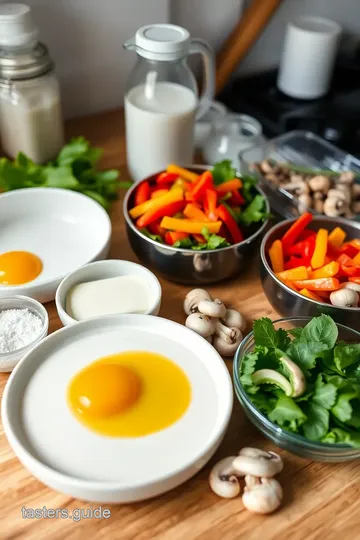Vibrant Open Face Veggie Omelette
Looking for a delicious breakfast idea? Here’s how to cook open face omelette with fresh veggies that your family will love! Sautéed goodness and fluffy eggs await!

- Let’s Cook Open Face Omelette with Fresh Veggies!
- Your Essential Ingredients Guide for a Perfect Omelette
- Mastering the Art of the Open Face Omelette with Fresh Veggies
- Pro Tips & Secrets for Your Omelette Adventure
- Perfect Presentation: Turning Your Omelette into a Work of Art
- Storage & Make-Ahead: Keeping the Good Stuff Fresh
- Creative Variations: Mix It Up!
- Complete Nutrition Guide: A Healthy Breakfast You Can Feel Good About
- Expert FAQ Solutions: Your Questions Answered!
- Recipe Card
Let’s Cook Open Face Omelette with Fresh Veggies!
Ever found yourself standing in your kitchen, staring at the fridge, wondering what to whip up for breakfast? i totally get that! one morning, feeling lazy, i cracked a few eggs into a bowl.
Before i knew it, a vibrant open face omelette was born! the best part? it turned out to be not just quick but downright delicious—especially when topped with the freshest veggies i could find.
If you’re curious about how to make an omelette so good it'll make you whole week, stick around.
The Journey of the Omelette
The omelette, my friends, has been a classic breakfast recipe for ages. you can trace its roots back to the ancient greeks, but let’s not get too fancy here! fast forward to today, and open face omelettes are all the rage.
I mean, who doesn’t love that beautiful display of sautéed vegetables resting atop fluffy eggs? it’s like having your breakfast and art on the same plate!
Now about the nitty-gritty: prepping this healthy omelette recipe takes around 20 minutes from start to finish —that’s less time than it takes to scroll through instagram! plus, it’s super easy to make.
No culinary degree is required. just a few basic kitchen skills, and you’re all set!
Why You’ll Love This Omelette
Let’s chat benefits because this dish is a notable in many ways. first off, the nutritional value of omelettes is impressive! eggs are packed with protein and healthy fats, which will have you feeling full for hours.
Toss in some sautéed vegetables, like bell peppers and spinach, and you’ve got yourself a nutritional powerhouse. seriously, who needs a smoothie when you've got this amazing egg-based breakfast dish ?
Also, it’s a versatile option! if you have a few leftover veggies in your fridge, throw them in! it’s one of the best vegetarian breakfast ideas you can whip up.
Fancy a change? try different filling combinations each week, from southwest-style with black beans and avocado to mediterranean with feta and olives.
Oh, and let’s not forget— homemade omelette ingredients can be as simple or gourmet as you want!
The Perfect Occasion
Now, when’s the best time to serve this beauty? well, anytime really! but honestly, it feels like a bit of a showstopper for brunch with friends or a cozy sunday morning at home.
Pair it with a fresh side salad or some crunchy toast, and you’ve got yourself a savory brunch meal that’ll impress anyone.
Trust me, your family will be asking for it on repeat!
Transition to Ingredients
Alright! now that you've got the scoop on why you’ll want to make this open face omelette , it’s time to dive into those delicious ingredients you’ll need.
Trust me, they’re worth the hype!
Here’s a quick rundown: you’ll start with four large eggs (240 ml), some milk (just 2 tablespoons), and the usual suspects like salt and pepper to boost those flavors.
For the filling, grab some bell peppers, onions, and fresh spinach—easy, right? but don’t worry if you want to mix it up! use what you have on hand or what’s in season; it’ll only make your omelette that much better.
So, are you ready to bring your breakfast game to a whole new level? Let’s get cooking!

Your Essential Ingredients Guide for a Perfect Omelette
Let’s be real, cooking can feel like a mystery sometimes, but with the right ingredients and a little bit of know-how, you can whip up a killer dish that’ll leave everyone asking for seconds.
Today, let’s dive into a simple yet delicious dish that’s a staple in many american homes: the open face omelette with fresh veggies .
This guide will cover everything from the basics to some cool tips that’ll make your cooking experience way easier.
Premium Core Components
When it comes to your omelette, the base ingredients are key.
- Eggs : You’ll need about 4 large eggs (that’s 240 ml). Fresh eggs are always the best. They should feel heavy and have a smooth shell.
- Milk : A splash of 2 tablespoons (30 ml) helps keep your omelette light and fluffy. If you’re feeling adventurous, substitute with cream or even a plant-based milk.
- Salt and Pepper : Always use a generous pinch of each for flavor.
So, how do you store these babies? eggs can sit in their carton in the fridge for 3-5 weeks . keep your milk in the coldest spot, and it’s good for about 7-10 days after opening.
Signature Seasoning Blend
Now, let’s talk flavor. A good omelette can go from ho-hum to gourmet with just a bit of seasoning.
- Spices : A dash of garlic powder or onion powder can pump up the taste without adding much hassle.
- Herbs : Fresh herbs like basil and parsley are perfect. Just toss them in before serving for a fresh punch.
Depending on where you live, you might find regional twists. Think about adding sautéed jalapeños for a Southwestern flair or crumbled feta for a Mediterranean vibe!
Smart Substitutions
Here’s the deal—sometimes life throws you a curveball, and you don’t have the exact ingredients on hand. No worries!
- If you’re out of eggs : Mashed silken tofu can substitute in a pinch for a plant-based option.
- No milk? Try yogurt or even skip it for a more straightforward flavor.
- Veggie swaps : If spinach isn't your thing, throw in some kale or even zucchini. Each brings its own unique flavor and texture!
Kitchen Equipment Essentials
Okay, let’s get technical. To make your omelette, you need a few basic tools.
- A mixing bowl and a whisk for blending your eggs and milk.
- A good non-stick skillet is an absolute must. This prevents the eggs from sticking and makes flipping a breeze.
- Don't forget a spatula , because, let’s be real, you want to avoid any omelette chaos in the kitchen!
For easy clean-up, use a skillet that’s dishwasher safe. That way, your kitchen doesn’t look like a war zone after breakfast.
look into Into Your Omelette Adventure
With your ingredients and tools lined up, it’s time to get cooking! a homemade omelette not only tastes great but also packs a punch of protein and nutrients—perfect for those hectic mornings.
Trust me, once you wrap your head around how to make an omelette, the flavor possibilities are endless.
Imagine all the lovely sautéed vegetables being mixed with that fluffy egg base, creating an easy veggie omelette that everyone can enjoy.
Using fresh ingredients from your farmers' market can even elevate this into one of those gourmet breakfast options everyone raves about.
As you embark on your journey to cook an open face omelette with fresh veggies , remember these tips: use a low heat, don’t rush the cooking process, and most importantly, have fun with it! you’ll find an omelette can be a blank canvas for all your culinary creativity.
So grab those eggs, chop up your favorite veggies, and let’s make some magic happen in the kitchen! the outcome? a stylish and satisfying dish that’ll kickstart your day.
It’s all about making breakfast feel special, right? let’s get to those step-by-step instructions ...
Mastering the Art of the Open Face Omelette with Fresh Veggies
Alright, friends, let’s talk about something that’s near and dear to my breakfast-loving heart: the open face omelette with fresh veggies .
It’s a dish that's not just easy-peasy to throw together; it’s also a colorful canvas ready to showcase whatever seasonal treasures you can find at the market.
Trust me, after discovering how to whip one of these up, you’ll never look at breakfast the same way again!
Essential Prepping Steps
Before you even crack those eggs, let’s chat about the essential prep steps. the first golden rule of professional cooking is mise en place .
That means you’ve got everything prepped and in its place before you start cooking. slice up some bell peppers, onions, and maybe even toss in some cherry tomatoes.
Seriously, having your ingredients ready makes all the difference.
Next up? time management ! grab your measuring spoons and get your equipment ready: a mixing bowl, a whisk, and a non-stick skillet.
Set aside about ten minutes for active prep and another ten for cooking. set a timer if you need to—nothing like a little pressure to keep you on your toes!
Organization is key too. keep your cutting board clean and your workspace tidy. you don’t want to hunt for your spatula while the eggs are screaming for attention! and last but definitely not least, safety first.
Keep that knife sharpened (dangerous but handy!) and remember that hot pans can lead to some nasty burns if you’re not careful.
Step-by-Step Process
Ready to dive into making your open face omelette? Here we go!
-
Prep the Veggies: Dice about 1/2 cup of bell pepper and onion, chop 1 cup of fresh spinach, and halve 1/4 cup of cherry tomatoes.
-
Whisk it up: grab your mixing bowl and combine 4 large eggs, 2 tablespoons of milk, a pinch of salt, and some pepper.
Give it a good whisk until it’s all blended together.
-
Sauté time: heat 1 tablespoon of olive oil in a non-stick skillet over medium heat. toss in those diced onions and bell peppers, sautéing for about 3- 4 minutes until they start to soften.
Add the spinach and cherry tomatoes for another 1- 2 minutes until wilted.
-
Egg mixture over vegetables: pour the egg mix over those goodies in the skillet. really take a moment here; you want every bit of that filling to dance in the egg mixture.
Now, reduce the heat to low and let it cook.
-
Cooking perfection: keep an eye on it for about 6- 8 minutes . you’re looking for a set middle with a slightly custardy texture—that’s the magic.
If you’re adding cheese, sprinkle it on during the last minute.
-
Finale: Slide that beauty onto a plate, and voila! Cut into pieces if you’d like and serve it up hot!
Expert Techniques
You want to feel like a pro in your kitchen, right? here are some expert techniques . use fresh, seasonal vegetables for the best taste.
If you’re digging a fluffy omelette, really whip those eggs—more air means more fluff!
A nifty trick? cook on low heat to avoid a brown, tough omelette at the bottom. if at first, you don’t succeed, don’t sweat it! troubleshooting tip: if your omelette doesn’t flip perfectly, remember it’s still delicious, even if it looks more ‘rustic’ than ‘instagrammable'.
Success Strategies
Let me tell you, it’s easy to mess this dish up—but it’s even easier to succeed with a few success strategies .
Avoid overcooking; a perfectly cooked omelette should still be slightly jiggly in the center. also, quality assurance tip: use fresh herbs like chives or parsley for a gourmet touch right before serving.
Make-ahead options ? you bet! whip up the veggie sauté the night before and just mix it with eggs in the morning for a quick breakfast.
You’ll be eating like royalty in no time!
In a nutshell, if you follow these simple steps, you’ll be on your way to creating a scrumptious open face omelette with fresh veggies that will wow anyone at your breakfast table.
Don't forget to pair it with a light salad or some toast, and you’re golden.
Stay tuned for the next section, where we’ll dive deeper into additional information —tips, veggie combinations, and ways to elevate your omelette game. Happy cooking!

Pro Tips & Secrets for Your Omelette Adventure
When i first ventured into the world of omelettes, i was convinced i’d end up with a gooey mess every time.
Oh boy, was i wrong after trying the open face omelette with fresh veggies ! here’s the scoop: mastering the omelette is all about tiny details that make a big difference!
Chef’s personal insights: you know that moment when you take the first forkful, and it feels like a party in your mouth? that happens when you get the right balance of flavors.
I absolutely recommend using fresh, seasonal veggies. they're not just tastier, they also come loaded with nutrients that really up the health factor of your easy veggie omelette.
Time-saving techniques: i learned the hard way that prepping all your ingredients beforehand saves a ton of hassle. slice and dice your veggies and have them ready to go before you whisk the eggs.
Makes the cooking process feel like smooth sailing!
Flavor Enhancement Tips: Don’t sleep on seasoning! Add salt and pepper to your eggs before whisking for unbeatable flavor. And a pinch of garlic powder or even a dash of hot sauce can elevate your breakfast from basic to bomb!
Presentation advice: this is where the magic happens! slide that beauty onto a plate, garnish with fresh herbs (dill or chives are fantastic), and maybe toss on a few cherry tomatoes for color.
Trust me, no one will believe you made it yourself!
Perfect Presentation: Turning Your Omelette into a Work of Art
Listen, we eat first with our eyes, right? So let’s chat about how to make your open face omelette look as fabulous as it tastes!
Plating techniques: lay your omelette flat on the plate; let the golden eggs and colorful veggies shine. if you want to get fancy, consider plating it in a swirl or a wedge shape.
Garnish Ideas: A little sprinkle of fresh herbs can go a long way. I love to throw on a bit of fresh parsley or a couple of sliced scallions. Make it pop!
Color combinations: think about the rainbow! i try to include a mix of red bell peppers, vibrant greens, and orange-yellow yolks.
This not only looks pretty but also adds a variety of vitamins and minerals to your meal.
Visual Appeal Tips: Serving it with a side of mixed greens makes everything look more inviting. Plus, you get that extra crunch alongside the fluffy omelette!
Storage & Make-Ahead: Keeping the Good Stuff Fresh
If you’re like me, hustle and bustle often mean breakfast needs to be easy and quick. Here’s how to prepare ahead:
Storage Guidelines: After making your homemade omelette , if you have leftovers, let it cool completely and place it in an airtight container. It lasts about 3 days in the fridge.
Preservation Methods: If you’ve made a bulk batch, consider freezing individual portions wrapped tightly in plastic wrap and then in foil. They can last a month in the freezer!
Reheating Instructions: You can reheat in the microwave for about a minute (give or take, depending on your microwave). Or, for a crispy finish, give it a quick heat in a skillet.
Freshness Duration: I wouldn’t push it past three days in the fridge—better safe than sorry, right?
Creative Variations: Mix It Up!
This is where the world of omelettes gets exciting!
Flavor Adaptations: Want a Southern kick? Toss in some crumbled sausage or make it gourmet with sautéed mushrooms and goat cheese.
Dietary Modifications: Going egg-free? You can whip up a chickpea flour batter to mimic an omelette’s texture. They're called "besan omelettes" and are delicious!
Seasonal Twists: Use whatever veggies are in season. Spring has fresh asparagus and early summer means sweet corn. The possibilities are endless!
Regional Variations: How about a Mexican spin? Load it up with jalapeños, avocado, and a sprinkle of cotija cheese for some zest!
Complete Nutrition Guide: A Healthy Breakfast You Can Feel Good About
Here’s a little breakdown of what you're getting with this healthy omelette recipe :
Detailed Breakdown: Per serving, you’re lookin’ at about 320 calories and 22g of protein! That's a solid punch for a breakfast meal!
Health Benefits: Eggs are a powerhouse! They’re dense in nutrients and are a fantastic source of egg protein content . Pairing them with fresh veggies means a boost in vitamins and minerals.
Dietary Considerations: You can easily cater this dish to be vegetarian or plant-based depending on your ingredients. Plus, it’s low-carb if you're watching those carbs!
Portion Guidance: Each serving is generous enough to keep you full but not so much that it feels like a chore to eat. Perfect for breakfast or even a brunch treat!
Expert FAQ Solutions: Your Questions Answered!
You might be wondering things like, “Why didn’t my omelette come out fluffy?” Here’s the scoop.
Common questions: (trust me, we’ve all been there!) a lot of it comes down to your heat setting and how you whisk those eggs.
Too high heat = rubbery omelette. you want that low and slow cooking, people!
Troubleshooting Guide: If things don’t go as planned, don’t stress! Just remember, practice makes perfect. If your omelette breaks, you can always call it a frittata instead—it's not a total loss!
Success Tips: Always use a non-stick skillet; this is non-negotiable for flawless omelettes. Also, do not rush the cooking process!
Variations Explained: Want to swap veggies or cheeses? Go for it! Just keep it balanced.
So there you have it! by diving into the world of the open face omelette with fresh veggies , you unlock a versatile dish packed with flavor, nutrition, and endless variations that are sure to impress anyone at your breakfast table.
Don't be afraid to personalize it; make it your own! happy cooking!

Vibrant Open Face Veggie Omelette Card

⚖️ Ingredients:
- 4 large eggs
- 2 tablespoons milk
- Salt and black pepper to taste
- 1 tablespoon olive oil
- 1/2 cup bell pepper, diced
- 1/2 cup onion, diced
- 1 cup fresh spinach, chopped
- 1/4 cup cherry tomatoes, halved
- 1/4 cup shredded cheese (optional)
🥄 Instructions:
- Step 1: Dice bell pepper and onion. Chop spinach and halve cherry tomatoes.
- Step 2: In a mixing bowl, combine eggs, milk, salt, and pepper. Whisk until fully blended.
- Step 3: Heat olive oil in a non-stick skillet over medium heat. Add diced onion and bell pepper; sauté for 3-4 minutes until softened. Stir in spinach and cherry tomatoes; cook for another 1-2 minutes until spinach wilts.
- Step 4: Pour the egg mixture over the sautéed vegetables in the skillet. Gently stir to distribute the filling, then reduce heat to low.
- Step 5: Cook for 6-8 minutes until the eggs are set but slightly custardy on top. If using cheese, sprinkle on top during the last minute of cooking.
- Step 6: Slide the omelette onto a plate, cut into pieces if desired, and serve immediately.
Previous Recipe: Quick and Delicious: Cook Hearty Hash Chili in 30 Minutes!
Next Recipe: How to Make Grilled Salmon & Creamy Goat Cheese Salad: A Flavorful Delight
